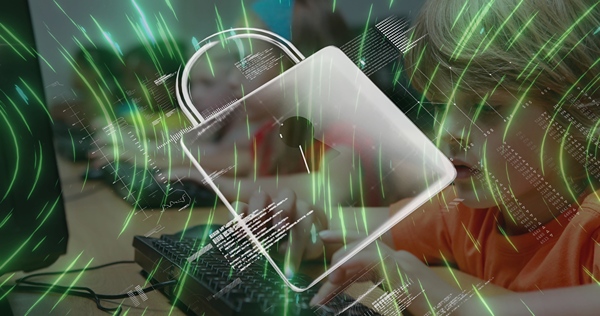Beyond Passwords: The Future of Biometric Security and Its Uncharted Pitfalls
Will the central question of how to secure our digital lives ever go away? Not likely. But the avenues explored will continue to change. As fast as technology evolves cyber criminals will also adapt. This drives even more change to find ways to stay ahead of scammers and ensure our online privacy.
Passwords have been our trusty gatekeepers for decades, but let’s face it: they’re a headache. Sure, there have been great innovations that help us all maintain strong unique passwords for all of our accounts.
Password managers and setting up multi-factor authentications are great developments, but too many people do not take advantage of even the most basic recommended security options.
The Future of Biometric Security
So, what if there was a way to ditch passwords altogether? Enter biometric security—a futuristic approach that’s already making its way into our daily lives, from fingerprint scanners to facial recognition. It sounds like something out of a sci-fi movie, but it’s very much a reality.
However, as with all things tech, there’s more beneath the surface. While biometrics promise convenience and enhanced security, they also introduce new challenges that we’re just beginning to understand.
The Allure of Biometrics
Biometric security is based on the idea that each person has unique biological traits that can be used to verify their identity. This includes fingerprints, facial structure, iris patterns, and even voice recognition. The appeal here is obvious—no more having to manage multiple passwords, no need to write down security codes, and a system that theoretically knows you better than anyone else.
Consider the convenience of unlocking your phone with a quick glance or a simple touch. Just a few years ago that was revolutionary. Today, it’s standard on our smart phones. However, on personal, work, and school PC’s, Macs, these possibilities are not their yet. And will it someday be possible to walk up to a banking machine and withdraw cash without a card?
Ideally, biometrics can offer a higher level of security. Unlike a password that can be guessed or stolen, your fingerprints, face, and eyes are unique to you. This uniqueness makes it much harder for attackers to gain unauthorized access.
The New Frontier of Security
As we shift towards a more biometric-driven security landscape, it’s important to understand why this is considered a step forward. The truth is traditional passwords are inherently flawed. People tend to reuse passwords across multiple sites, choose easily guessable phrases, and fall prey to phishing attacks. Biometric data, on the other hand, is far less susceptible to these common pitfalls.
Moreover, the adoption of biometrics isn’t just about convenience. It’s also a response to the growing sophistication of cyber threats. Hackers are becoming more skilled at breaking into systems, and organizations are constantly searching for more secure methods to protect sensitive information. By relying on something as unique as a person’s fingerprint or iris, biometric security adds an additional layer of defense that’s much harder to breach.
Uncharted Pitfalls: What Could Go Wrong?

While biometric security seems like a clear win, it’s not without its own set of challenges—some of which are downright unsettling.
Privacy Concerns:
When you use biometric authentication, you’re not just handing over a password—you’re handing over a piece of yourself. This raises significant privacy concerns. What happens if a company that stores you or family members biometric data gets hacked? Unlike passwords, you can’t change your fingerprint or facial structure if that information is compromised. This makes biometric data a highly attractive target for cybercriminals.
False Positives and False Negatives:
No technology is perfect, and biometric systems are no exception. False positives (where the system incorrectly identifies someone as you) and false negatives (where it fails to recognize you) can be frustrating at best and dangerous at worst. Imagine being locked out of your own device or, even more concerning, someone else gaining access to your accounts because they are your doppelganger.
Ethical and Legal Implications:
As biometric data becomes more integrated into our lives, the ethical and legal questions surrounding its use become more pressing. Who owns your biometric data? How is it being used, and by whom? These questions don’t have straightforward answers, and the legal landscape is still catching up with the technology.
The Rise of Deepfakes and Spoofing:
With advances in technology, the threat of deepfakes—hyper-realistic but fake videos and images—poses a new risk to biometric systems. A skilled hacker might be able to create a convincing replica of your face or voice, fooling the system into granting them access. As this technology becomes more accessible, the security of biometric systems will need to evolve rapidly to stay ahead of potential threats.
The Future of Biometric Security
Despite these challenges, biometric security isn’t going away. In fact, it’s likely to become even more prevalent as technology advances. We may see a shift towards multi-modal biometrics, where multiple types of biometric data are used together to create a more robust security system.
For example, a system might require both a fingerprint scan and voice recognition before granting access, reducing the likelihood of false positives and improving overall security.
Another area of growth could be in the development of behavioral biometrics, which analyze patterns in the way you interact with your device—such as typing rhythm or walking gait. These subtle cues could add an additional layer of security that’s even harder for hackers to replicate.
Balancing Convenience and Security
The move beyond passwords towards biometric security is an exciting development in the world of IT. It promises a future where our devices and accounts are not only easier to access but also more secure. However, as we embrace this new technology, it’s never been more vital to remain aware of the potential pitfalls and work towards solutions that protect both our security and privacy.
As with the evolution of any technology, new or old, balance is key. The convenience of biometric security is undeniable, but we must approach this brave new world with our eyes wide open, understanding both the potential and the risks. Only then can we fully harness the power of biometrics while safeguarding our digital future.
Last Updated on November 21, 2024 by SafeSearchKids Editorial Team






